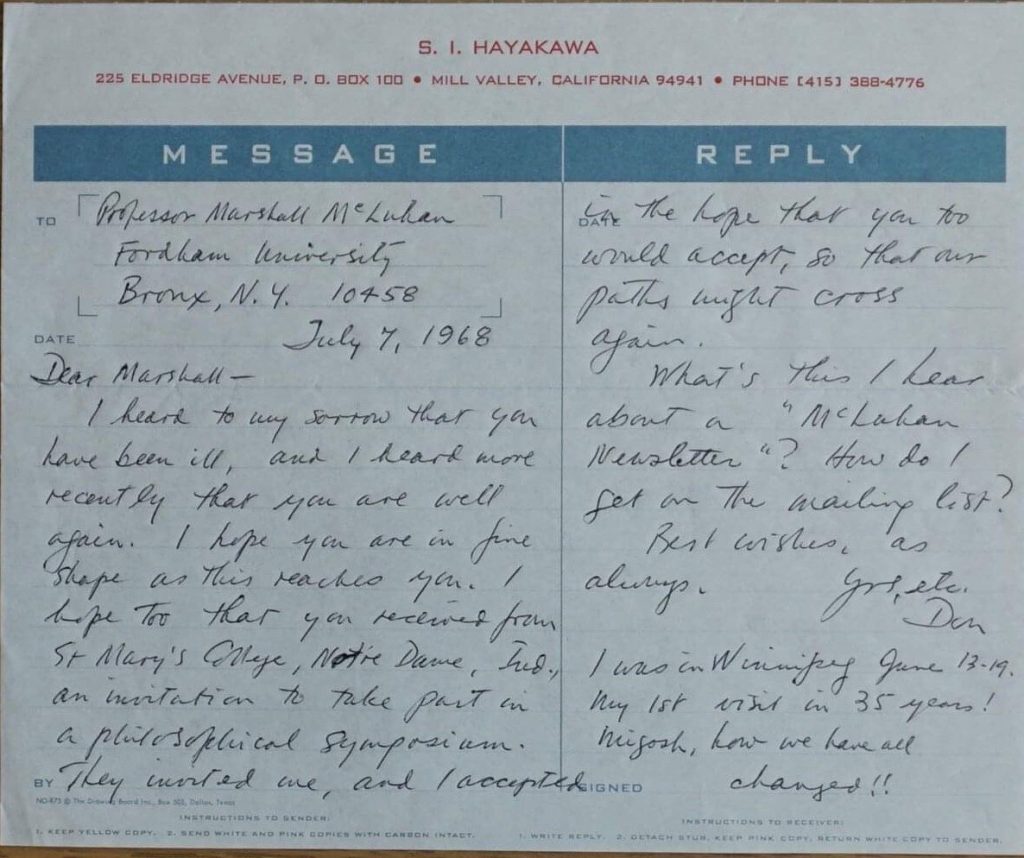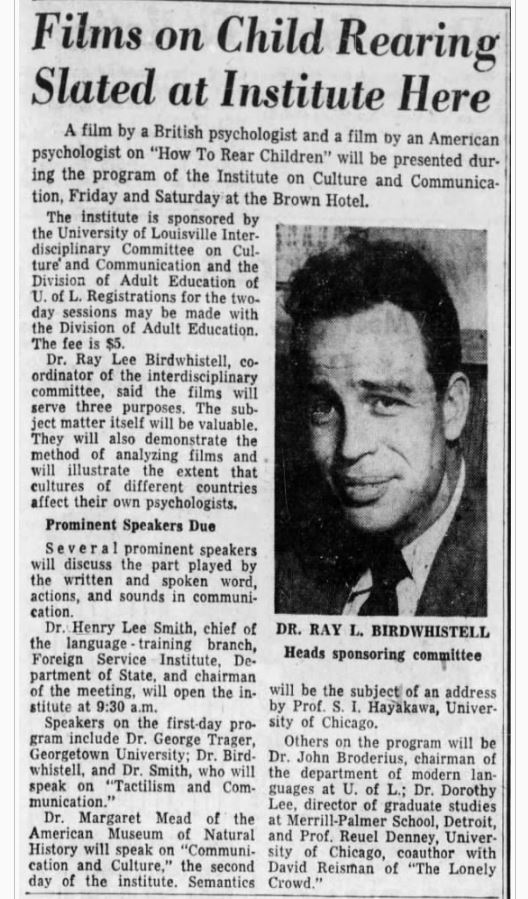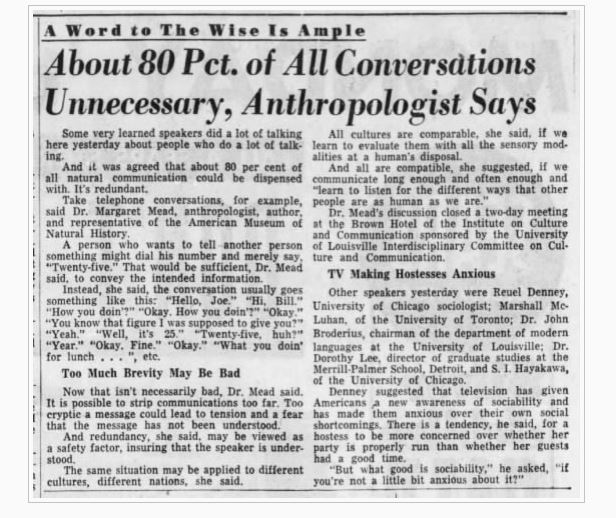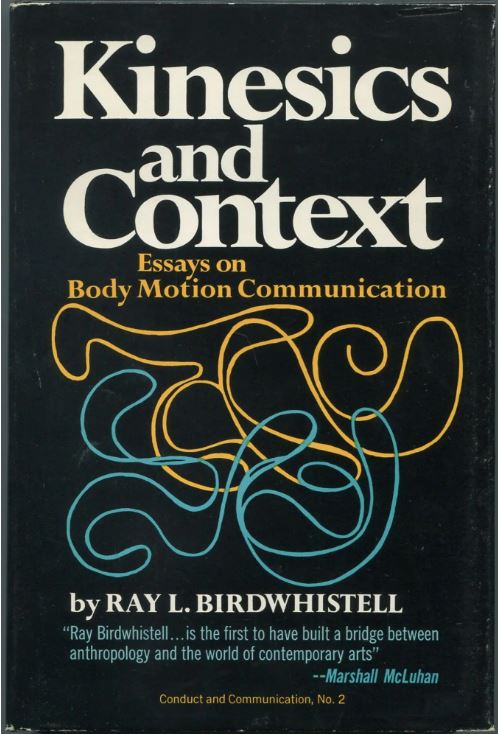Two decades apart, the final lines of McLuhan essays from 1944 and 1964 called for “plenary critical judgment” and for the acquisition of “plenary consciousness”.1
1944:
the arduous stage of the journey (…) remains to be accomplished before winning an overall view, which is plenary critical judgment. (Poetic vs Rhetorical Exegesis: The Case for Leavis against Richards and Empson)2
1964:
The overwhelming trend of film is toward involvement in the creative and social processes alike. Film is now able to digest any kind of theme and to handle it in the mode of an inclusive awareness. The “phantom city phaked of philim pholk” is acquiring the character of plenary consciousness. (A Phantom City Phaked of Philim Pholk [FW 264.19–20] or Where the Hand of Man Never Set Foot [FW 203.15-16])3
These concluding lines from McLuhan age 33 and age 53 serve to plot the continuity of the strategy he pursued over his 50-year intellectual life from 1930 (age 19) to 1980 (age 69). Namely, if humans are to survive the technological environment they have created, they must achieve decisive clarity about themselves (the interior landscape) in analogous fashion to the clarity achieved (but only in the last two centuries) about the physical world (the exterior landscape). This, in turn, requires identification of a new field, or fields, defined by the totality, or plenum, of the elements constituting it/them.4 But ‘totality’ here is open, not closed — just as chemistry posits the totality of Mendeleev’s table but is still uncovering ‘new’5 elements constituting that totality as we speak.
McLuhan took over this strategy, and the implicated need to communicate it by instigating its investigation, from his two philosophy teachers at the University of Manitoba, Henry Wright and Rupert Lodge. They, in turn, continued a line running back through John Watson (1847–1939) and Edward Caird (1835–1908) to Hegel (1770-1832).
Wright and Lodge were two of the contributors (out of eleven) to the Festschrift volume dedicated to Watson on the occasion of the 50th anniversary (1872-1922) of his teaching career at Queen’s University: Philosophical Essays Presented to John Watson. Their essays (‘A Plea for Eclecticism’ by Wright and ‘Moral Validity: A Study in Platonism’ by Lodge) must be studied in detail to understand the context of the philosophical theory in which McLuhan’s English studies at the University of Manitoba and then at Cambridge were cultured.6
To indicate this line from Hegel to McLuhan in preliminary fashion it suffices to note in regard to its two ends that McLuhan’s “medium is the message” from 1958 was central to Hegel’s proposed philosophical science from 1807 — 150 years earlier.
Phänomenologie des Geistes, ‘Vorrede’ (1807)
Daß an jedem Falschen etwas Wahres sei – in diesem Ausdrucke gelten beide, wie Öl und Wasser, die unmischbar nur äußerlich verbunden sind. Gerade um der Bedeutung willen, das Moment des vollkommenen Andersseins zu bezeichnen, müssen ihre Ausdrücke da, wo ihr Anderssein aufgehoben ist, nicht mehr gebraucht werden. So wie der Ausdruck der Einheit des Subjekts und Objekts, des Endlichen und Unendlichen, des Seins und Denkens usf. das Ungeschickte hat, daß Objekt und Subjekt usf. das bedeuten, was sie außer ihrer Einheit sind, in der Einheit also nicht als das gemeint sind, was ihr Ausdruck sagt…
In the expression that in everything false there is something of the truth, the two of them [the true and the false] are understood like oil and water, which can only outwardly be brought together [and are not already inwardly bound]. Precisely in order to designate the specificity [das Moment] of such absolute difference [between such ‘unmixable’ truth and falsehood], when that difference is cancelled or transcended [aufgehoben], the same designation of them cannot still be used. Similarly, the expression of the unity of subject and object, the finite and infinite, being and thought, etc, is problematic in that subject and object, etc, seem to mean what they do outside their unity, but in their unity they do not have the sense [anymore] of that [differentiated] designation…
Hegel’s point is that the poles of an opposition — like truth/falsehood, subject/object, finitude/infinitude, being/thought — depend for their meaning on their relation; and that such relation varies according to the degree of difference vs unity represented by it. The specification of meaning therefore turns on the prior specification of the range of possible unity/difference ratios or media. “The medium is the message.”7
In his 1964 ‘Phantom City Phaked of Philim Pholk’ lecture, McLuhan set out these same steps as follows (where his visual/auditory ratio recapitulates Hegel’s unity/difference)8:
- “some basic sensory reorganization has occurred in our corporate lives in recent decades. Indeed, one need have looked no further than the movies to have encountered extraordinary signs of change in sensory (…) preference“
- “With the lowering of the visual level the other senses came up, automatically, with a complete change of outlook and attitude as a consequence”9
- “The better we can grasp the properties of the components in this dynamic interaction, the more we can cope”
- “It is perhaps overdue that we should abandon mere reaction or acquiescence in favour of due understanding of these great archetypal forces“
- “The only viable strategy in learning today [= the pursuit of ‘due understanding’] is to resort to (…) to pattern recognition” [of the particular structures of these individual ratios and of the spectrum of these ratios in relation to each other]
- “It is possible to read the (…) level of the sensory usage in any society or individual by the degree of stress manifested” [in the ratio of the visual/auditory poles to each other]10
- McLuhan evidently liked to close his writings in this “plenary” fashion. Here are the final sentences of his 1947 review ‘Inside Blake and Hollywood’: “There has been no lack of critics who have proclaimed the uplifting qualities of the movies without having noticed anything whatever of what was going on in them. Mr. Tyler (in Magic and Myth of the Movies, 1947) is right, therefore, to concentrate attention on the complexity and eminent snideness of movie art as preliminary to opening up a plenary critique.” (Sewanee Review 55:4) ↩
- Sewanee Review, 52:2, 1944. Compare the first sentence of this essay: “American critics once alerted to the new movements in English criticism would probably bog down in the rhetorical exegesis of Richards and Empson rather than adapt it, as FR Leavis did, as a means in a critical journey to the full act of plenary critical judgment.” The entire essay unfolds within the brackets set by this phrase of “plenary critical judgment”. For further discussion see Poetic vs Rhetorical Exegesis 1, Poetic vs Rhetorical Exegesis 2, and Plenary Judgement. ↩
- Lecture at the National Film Board of Canada symposium, ‘The Future of Film in Canada’, August 5, 1964. Published posthumously in The Book of Probes, ed Eric McLuhan, William Kuhns and David Carson, 2003. ↩
- The circularity of this notion is plain. Only judgement which itself has “the character of plenary consciousness” can authentically identify and investigate the required “plenary” field. Such circularity is one more way in which the image of maelstrom is fitting to the problematic at stake. ↩
- ‘New’ in the order of consciousness, not in the order of nature. ↩
- For detailed discussion see the posts on Wright and Lodge. ↩
- “The medium is the message” has a number of readings, all of which must be heard together in it. (1) The medium is what first of all makes a message possible. So, eg, a word does not make communication possible, but communication makes something like a word possible. (2) The medium is what determines the meaning of the message (considered as some articulation of the structural poles of that medium). (3) The medium must be the focus of the open collective investigation of communication, aka, “understanding media”. (4) ‘The medium is the message’ just as ‘culture is our business’. The medium (media) as the basis of sustainable culture (cultures) is the key to human survival. The medium is the coherence of such a multiple plurality, the ontological condition of their peace. Cf, ‘James Joyce: Trivial and Quadrivial (1953): “the plenary scope of patristic exegesis (…) can perhaps be taken as a mark of the profound coherence of modern culture when viewed at its best levels.” ↩
- It is characteristic of McLuhan’s formulation of the tradition to suggest that focus on the visual/auditory ratio as defining both individual psychologies and social cultures may be more fruitful than focus on unity/difference. However, his frequent recourse to “inclusive awareness” (in, eg, the head citation above from his ‘Phantom City’ lecture), vs exclusive awareness, illustrates his recurrent attention to unity/difference as well. “Inclusive awareness” is awareness of unity in difference; exclusive awareness is awareness of (subjective genitive!) the ultimate incompatibility of unity and difference. The riddle posed by the tradition is how these two basic types of awareness can be fundamentally different without collapsing into exclusivity. “The gap is where the action is.” ↩
- The “automatic” inverse relation (Heraclitus’ ‘οδός) of up and down (Heraclitus’ άνω κάτω) is what McLuhan in the same essay calls “the degree of stress manifested” (see the following note). ↩
- McLuhan: “It is possible to read the visual level of the sensory usage in any society or individual by the degree of stress manifested in favour of neatness and classification” — which also yields, ‘automatically’, a reading of the inversely related auditory level of (dual genitive) untidiness and disorder. ↩



